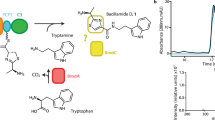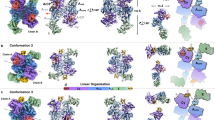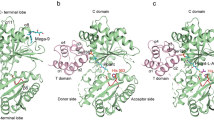Abstract
Non-ribosomal peptide synthetase (NRPS) mega-enzyme complexes are modular assembly lines that are involved in the biosynthesis of numerous peptide metabolites independently of the ribosome1. The multiple interactions between catalytic domains within the NRPS machinery are further complemented by additional interactions with external enzymes, particularly focused on the final peptide maturation process. An important class of NRPS metabolites that require extensive external modification of the NRPS-bound peptide are the glycopeptide antibiotics (GPAs), which include vancomycin and teicoplanin2,3. These clinically relevant peptide antibiotics undergo cytochrome P450-catalysed oxidative crosslinking of aromatic side chains to achieve their final, active conformation4,5,6,7,8,9,10,11,12. However, the mechanism underlying the recruitment of the cytochrome P450 oxygenases to the NRPS-bound peptide was previously unknown. Here we show, through in vitro studies, that the X-domain13,14, a conserved domain of unknown function present in the final module of all GPA NRPS machineries, is responsible for the recruitment of oxygenases to the NRPS-bound peptide to perform the essential side-chain crosslinking. X-ray crystallography shows that the X-domain is structurally related to condensation domains, but that its amino acid substitutions render it catalytically inactive. We found that the X-domain recruits cytochrome P450 oxygenases to the NRPS and determined the interface by solving the structure of a P450–X-domain complex. Additionally, we demonstrated that the modification of peptide precursors by oxygenases in vitro—in particular the installation of the second crosslink in GPA biosynthesis—occurs only in the presence of the X-domain. Our results indicate that the presentation of peptidyl carrier protein (PCP)-bound substrates for oxidation in GPA biosynthesis requires the presence of the NRPS X-domain to ensure conversion of the precursor peptide into a mature aglycone, and that the carrier protein domain alone is not always sufficient to generate a competent substrate for external cytochrome P450 oxygenases.
This is a preview of subscription content, access via your institution
Access options
Subscribe to this journal
Receive 51 print issues and online access
$199.00 per year
only $3.90 per issue
Buy this article
- Purchase on Springer Link
- Instant access to full article PDF
Prices may be subject to local taxes which are calculated during checkout





Similar content being viewed by others
References
Hur, G. H., Vickery, C. R. & Burkart, M. D. Explorations of catalytic domains in non-ribosomal peptide synthetase enzymology. Nat. Prod. Rep. 29, 1074–1098 (2012)
Yim, G., Thaker, M. N., Koteva, K. & Wright, G. Glycopeptide antibiotic biosynthesis. J. Antibiot. (Tokyo) 67, 31–41 (2014)
Cryle, M. J., Brieke, C. & Haslinger, K. in Amino Acids, Peptides and Proteins Vol. 38, 1–36 (The Royal Society of Chemistry, 2014)
Bischoff, D. et al. The biosynthesis of vancomycin-type glycopeptide antibiotics-a model for oxidative side-chain cross-linking by oxygenases coupled to the action of peptide synthetases. ChemBioChem 6, 267–272 (2005)
Bischoff, D. et al. The biosynthesis of vancomycin-type glycopeptide antibiotics-new insights into the cyclization steps. Angew. Chem. Int. Ed. Engl. 40, 1693–1696 (2001)
Bischoff, D. et al. The biosynthesis of vancomycin-type glycopeptide antibiotics—the order of the cyclization steps. Angew. Chem. Int. Ed. Engl. 40, 4688–4691 (2001)
Süssmuth, R. D. et al. New advances in the biosynthesis of glycopeptide antibiotics of the vancomycin type from Amycolatopsis mediterranei. Angew. Chem. Int. Ed. Engl. 38, 1976–1979 (1999)
Haslinger, K., Maximowitsch, E., Brieke, C., Koch, A. & Cryle, M. J. Cytochrome P450 OxyBtei catalyzes the first phenolic coupling step in teicoplanin biosynthesis. ChemBioChem 15, 2719–2728 (2014)
Woithe, K. et al. Oxidative phenol coupling reactions catalyzed by OxyB: a cytochrome P450 from the vancomycin producing organism. Implications for vancomycin biosynthesis. J. Am. Chem. Soc. 129, 6887–6895 (2007)
Zerbe, K. et al. An oxidative phenol coupling reaction catalyzed by OxyB, a cytochrome P450 from the vancomycin-producing microorganism. Angew. Chem. Int. Ed. Engl. 43, 6709–6713 (2004)
Hadatsch, B. et al. The biosynthesis of teicoplanin-type glycopeptide antibiotics: assignment of P450 mono-oxygenases to side chain cyclizations of glycopeptide A47934. Chem. Biol. 14, 1078–1089 (2007)
Stegmann, E. et al. Genetic analysis of the balhimycin (vancomycin-type) oxygenase genes. J. Biotechnol. 124, 640–653 (2006)
Rausch, C., Hoof, I., Weber, T., Wohlleben, W. & Huson, D. Phylogenetic analysis of condensation domains in NRPS sheds light on their functional evolution. BMC Evol. Biol. 7, 78 (2007)
Stegmann, E., Frasch, H.-J. & Wohlleben, W. Glycopeptide biosynthesis in the context of basic cellular functions. Curr. Opin. Microbiol. 13, 595–602 (2010)
Walsh, C. T. & Wencewicz, T. A. Prospects for new antibiotics: a molecule-centered perspective. J. Antibiot. (Tokyo) 67, 7–22 (2014)
Butler, M. S. et al. Glycopeptide antibiotics: back to the future. J. Antibiot. (Tokyo) 67, 631–644 (2014)
Brieke, C. et al. Rapid access to glycopeptide antibiotic precursor peptides coupled with cytochrome P450-mediated catalysis: towards a biomimetic synthesis of glycopeptide antibiotics Org. Biomol. Chem. http://dx.doi/org/10.1039/C4OB02452D (2014)
Samel, S. A., Czodrowski, P. & Essen, L.-O. Structure of the epimerization domain of tyrocidine synthetase A. Acta Crystallogr. D 70, 1442–1452 (2014)
Bloudoff, K., Rodionov, D. & Schmeing, T. M. Crystal structures of the first condensation domain of CDA synthetase suggest conformational changes during the synthetic cycle of nonribosomal peptide synthetases. J. Mol. Biol. 425, 3137–3150 (2013)
Tanovic, A., Samel, S. A., Essen, L.-O. & Marahiel, M. A. Crystal structure of the termination module of a nonribosomal peptide synthetase. Science 321, 659–663 (2008)
Samel, S. A., Schoenafinger, G., Knappe, T. A., Marahiel, M. A. & Essen, L.-O. Structural and functional insights into a peptide bond-forming bidomain from a nonribosomal peptide synthetase. Structure 15, 781–792 (2007)
Keating, T. A., Marshall, C. G., Walsh, C. T. & Keating, A. E. The structure of VibH represents nonribosomal peptide synthetase condensation, cyclization and epimerization domains. Nature Struct. Mol. Biol. 9, 522–526 (2002)
Sosio, M. et al. Organization of the teicoplanin gene cluster in Actinoplanes teichomyceticus. Microbiology 150, 95–102 (2004)
Li, T.-L. et al. Biosynthetic gene cluster of the glycopeptide antibiotic teicoplanin: characterization of two glycosyltransferases and the key acyltransferase. Chem. Biol. 11, 107–119 (2004)
Haslinger, K. et al. The structure of a transient complex of a nonribosomal peptide synthetase and a cytochrome P450 monooxygenase. Angew. Chem. Int. Ed. Engl. 53, 8518–8522 (2014)
Uhlmann, S., Süssmuth, R. D. & Cryle, M. J. Cytochrome P450sky interacts directly with the nonribosomal peptide synthetase to generate three amino acid precursors in skyllamycin biosynthesis. ACS Chem. Biol. 8, 2586–2596 (2013)
Cryle, M. J., Meinhart, A. & Schlichting, I. Structural characterization of OxyD, a cytochrome P450 involved in β-hydroxytyrosine formation in vancomycin biosynthesis. J. Biol. Chem. 285, 24562–24574 (2010)
Cryle, M. J. & Schlichting, I. Structural insights from a P450 carrier protein complex reveal how specificity is achieved in the P450Biol ACP complex. Proc. Natl Acad. Sci. USA 105, 15696–15701 (2008)
van Wageningen, A. M. A. et al. Sequencing and analysis of genes involved in the biosynthesis of a vancomycin group antibiotic. Chem. Biol. 5, 155–162 (1998)
Pootoolal, J. et al. Assembling the glycopeptide antibiotic scaffold: the biosynthesis of from Streptomyces toyocaensis NRRL15009. Proc. Natl Acad. Sci. USA 99, 8962–8967 (2002)
Hunter, S. et al. InterPro in 2011: new developments in the family and domain prediction database. Nucleic Acids Res. 40, D306–D312 (2012)
Cole, C., Barber, J. D. & Barton, G. J. The Jpred 3 secondary structure prediction server. Nucleic Acids Res. 36, W197–W201 (2008)
Bogomolovas, J., Simon, B., Sattler, M. & Stier, G. Screening of fusion partners for high yield expression and purification of bioactive viscotoxins. Protein Expr. Purif. 64, 16–23 (2009)
Zerbe, K. et al. Crystal structure of OxyB, a cytochrome P450 implicated in an oxidative phenol coupling reaction during vancomycin biosynthesis. J. Biol. Chem. 277, 47476–47485 (2002)
Brieke, C. & Cryle, M. J. A facile Fmoc solid phase synthesis strategy to access epimerization-prone biosynthetic intermediates of glycopeptide antibiotics. Org. Lett. 16, 2454–2457 (2014)
Sunbul, M., Marshall, N. J., Zou, Y., Zhang, K. & Yin, J. Catalytic turnover-based phage selection for engineering the substrate specificity of Sfp phosphopantetheinyl transferase. J. Mol. Biol. 387, 883–898 (2009)
Bell, S. G., Tan, A. B. H., Johnson, E. O. D. & Wong, L.-L. Selective oxidative demethylation of veratric acid to vanillic acid by CYP199A4 from Rhodopseudomonas palustris HaA2. Mol. Biosyst. 6, 206–214 (2010)
Geib, N., Woithe, K., Zerbe, K., Li, D. B. & Robinson, J. A. New insights into the first oxidative phenol coupling reaction during vancomycin biosynthesis. Bioorg. Med. Chem. Lett. 18, 3081–3084 (2008)
Kabsch, W. XDS. Acta Crystallogr. D 66, 125–132 (2010)
McCoy, A. J. et al. Phaser crystallographic software. J. Appl. Crystallogr. 40, 658–674 (2007)
Emsley, P., Lohkamp, B., Scott, W. G. & Cowtan, K. Features and development of Coot. Acta Crystallogr. D 66, 486–501 (2010)
Adams, P. D. et al. PHENIX: a comprehensive Python-based system for macromolecular structure solution. Acta Crystallogr. D 66, 213–221 (2010)
Chen, V. B. et al. MolProbity: all-atom structure validation for macromolecular crystallography. Acta Crystallogr. D 66, 12–21 (2010)
Krissinel, E. & Henrick, K. Secondary-structure matching (SSM), a new tool for fast protein structure alignment in three dimensions. Acta Crystallogr. D 60, 2256–2268 (2004)
Holm, L. & Rosenström, P. Dali server: conservation mapping in 3D. Nucleic Acids Res. 38, W545–W549 (2010)
Larkin, M. A. et al. ClustalW and ClustalX version 2. Bioinformatics 23, 2947–2948 (2007)
Krissinel, E. & Henrick, K. Inference of macromolecular assemblies from crystalline state. J. Mol. Biol. 372, 774–797 (2007)
Acknowledgements
The authors thank A. Koch for assistance with protein expression; S. Bell for redox proteins; M. Gradl for assistance with mass spectrometry; M. Tarnawski and A. Meinhart for assistance with crystal harvesting and data processing; I. Schlichting and J. Wray for discussions; C. Roome for IT support; R. Süssmuth and A. Truman for sharing unpublished data. Diffraction data were collected at the Swiss Light Source, X10SA beamline, Paul Scherrer Institute, Villigen, Switzerland. We thank the Heidelberg team for data collection and the PXII staff for their support in setting up the beamline. M.J.C. is grateful to I. Schlichting for constant encouragement and to the Deutsche Forschungsgemeinschaft (Emmy−Noether Program, CR 392/1-1) for financial support.
Author information
Authors and Affiliations
Contributions
M.J.C. designed the study. K.H., M.P. and E.M. performed the biochemical experiments. C.B. performed the chemical synthesis and compound characterization. M.P., K.H. and M.J.C. solved the structures and performed the analysis. M.J.C. wrote the manuscript together with contributions from K.H., M.P. and C.B.
Corresponding author
Ethics declarations
Competing interests
The authors declare no competing financial interests.
Extended data figures and tables
Extended Data Figure 1 Overview and graphical summary of this study.
a, b, Final stages of teicoplanin aglycone biosynthesis (a) and vancomycin-type aglycone biosynthesis (b). c, d, In vitro binding studies demonstrated that the minimal interaction interface of OxyA–C is the conserved X-domain from the final module of the teicoplanin non-ribosomal peptide synthetase (c) and that the OxyBtei and OxyAtei enzymes required for peptide maturation are only active against peptide-bound PCP7-substrates that also contain this X-domain (d). These results support the hypothesis that in vivo aglycone formation occurs through the interaction of Oxy enzymes with module seven of the teicoplanin non-ribosomal peptide synthetase that then act upon the NRPS-bound linear heptapeptide precursor.
Extended Data Figure 2 Interaction of Oxy enzymes with NRPS domains studied by analytical size-exclusion chromatography and multi-angle light scattering.
a, b, Profiles of OxyBtei (red) shown with the profiles of the corresponding NRPS domain constructs and variants (orange) and mixtures of the binding partners in a 1:3 ratio (blue). c, Profiles of OxyAtei, OxyCtei, OxyEtei (red) shown with the profiles of the corresponding GB1–X constructs (orange) and mixtures of the binding partners in a 1:3 ratio (blue). Solid lines represent detection at 415 nm and dashed lines at 280 nm detection.
Extended Data Figure 3 Interaction of Oxy enzymes with NRPS domains studied by native-PAGE.
a, Top, overview of electrophoretic migration behaviour of OxyBvan and OxyBtei in the absence/presence of different NRPS domain constructs (GB1–PCP7, –PCP7–X, –PCP7–X–TE, –X; 1:3 molar ratio). Bottom, interaction studies of OxyBtei with NRPScep proteins and OxyBvan with NRPStei proteins. b, Overview of electrophoretic migration behaviour of OxyAtei, Btei and Ctei in the absence/presence of GB1–Xtei or GB1–PCP7–X–TEtei (1:3). c, Titration of OxyBtei (10 µM) with GB1–Xtei (0 to 30 µM) leading to the appearance of a new band with low electrophoretic mobility and the disappearance of free OxyBtei at equimolar concentrations. The bands corresponding to an Oxy/X complex are marked with an asterisk, those corresponding to an Oxy/PCP7–X–TE complex with a triangle and those corresponding to Oxy/PCP7–X with a square.
Extended Data Figure 4 X-domain active site in comparison to TycC5–6.
a, b, Comparisons of the X-domain both in isolation (green/orange; a) and in complex with OxyBtei (green/orange; b) to the active site of TycC5–6 (grey, solved with a bound sulphate ion): the effect of the altered X-domain active-site motif is to block the active site. Selected residues are shown as sticks. Hydrogen bonds are indicated by dashed black/grey lines for the X-domain and in red for the TycC5–6/sulphate distance.
Extended Data Figure 5 Structure of OxyBtei and multiple sequence alignment of the Oxy enzymes.
a, Structure of OxyBtei determined in complex with the X-domain. Secondary structure elements are labelled and coloured grey with the following exceptions: B-helix and loop region (magenta), D-helix (cherry red), E-helix (blue), F-helix (orange), G-helix (yellow), I-helix (cyan), β1-sheet (green), β2-sheet (purple), β3-sheet (orange), β4-sheet (yellow), haem shown as sticks (C atoms, red; N atoms, blue; O atoms, orange) with the haem iron shown as a red sphere. b, Sequence alignment of Oxy proteins from Actinoplanes teichomyceticus teicoplanin gene cluster23,24. Secondary structure and colour scheme same as a; catalytic residues are shown in orange; residues important for X-domain interaction are indicated in the three boxed regions, are in bold and highlighted in yellow for OxyBtei. Colours used for the corresponding residues from OxyAtei, OxyCtei and OxyEtei indicate agreement with the consensus sequence (green, match; blue, comparable interaction; red, potential mismatch).
Extended Data Figure 6 Model of the PCP7–X–OxyBtei complex in two possible arrangements.
a–d, Possible PCP position determined from the alignment of the P450sky–PCP7 complex trapped using a covalent azole inhibitor with the OxyBtei–X-domain complex (a, b) and the structure of the P450BioI–ACP complex (c, d). The X-domain is shown in grey, OxyBtei is shown in yellow, the haem of OxyBtei is shown in red sticks. a, b, The PCP7 (sky) is shown in magenta and the azole inhibitor covalently bound to the PCP is shown as pink sticks. c, d, The ACP is shown in blue and the phosphopantetheine-bound fatty acid is shown as blue sticks. The distance between the C terminus of the PCP/ACP and the N terminus of the X-domain is shown in a and c.
Extended Data Figure 7 HPLC-MS analysis of P450-catalysed peptide monocyclization.
a–d, Representative HPLC-MS chromatograms of in vitro OxyBtei (a), StaH (b), OxyBvan (c), CepF (d) turnover reactions with heptapeptide Tei7(Hpg3,7) or Van7(Hpg7) bound to GB1–PCP7–X (left) and GB1–PCP7 (right). Ions corresponding to the singly charged, linear (hydrolysed m/z 1,088, methylhydrazide m/z 1,116) and crosslinked monocyclic (hydrolysed m/z 1,086, methylhydrazide m/z 1,114 ) teicoplanin-like peptide and the linear (hydrolysed m/z 1,017.5, methylhydrazide m/z 1,045.5 ) and crosslinked monocyclic (hydrolysed m/z 1,015.5, methylhydrazide m/z 1,043.5 ) vancomycin-like peptide recorded using single-ion monitoring (SIM) in negative mode. Major peaks for each mass represent diastereomers due to racemization of the C-terminal Hpg residue and two regioisomers derived from methylhydrazine cleavage; smaller peaks can be caused by overlapping mass signal detection with ions from lower molecular weight species; additionally, racemization of such crosslinked products has also been previously observed39.
Extended Data Figure 8 HPLC-MS analysis of OxyBtei-catalysed cyclization of peptides presented by mutant variants of PCP7–X.
a–d, Representative HPLC-MS chromatograms of in vitro OxyBtei turnover reactions with substrate heptapeptide Tei7(Hpg3,7) bound to the different GB1–PCP7–X mutants (X1: R167A, R171A (a); X2: E290A, D291A (b); X3: E377A, R382A (c); X1–3: R167A, R171A, E290A, D291A, E377A, R382A (d)). Occurrence of ions corresponding to the singly charged, linear peptide (hydrolysed m/z 1,088, methylhydrazide m/z 1,116) and the crosslinked monocyclic product (hydrolysed m/z 1,086, methylhydrazide m/z 1,114) were recorded using SIM in negative mode. The origins of the multiple peaks observed for each mass are described in Extended Data Fig. 7.
Extended Data Figure 9 HPLC-MS analysis of P450-catalysed peptide bicyclization.
a–d, Representative HPLC-MS chromatograms of coupled in vitro OxyBtei plus OxyAtei (a), OxyCtei (b), or OxyAtei/OxyCtei (c) turnover reactions on heptapeptide Tei7(Hpg3,7) bound to GB1–PCP7–X (a, left, b, c) and GB1–PCP7 (a, right); or OxyBtei alone with hexapeptide Tei6(Hpg3) bound to MBP–PCP6 (d). Occurrence of ions corresponding to the singly charged, linear peptide (hydrolysed m/z 1,088, methylhydrazide m/z 1,116 (a–c); hydrolysed m/z 939, methylhydrazide m/z 967 (d)), crosslinked monocyclic product (hydrolysed 1,086 m/z, methylhydrazide 1,114 m/z (a–c); hydrolysed m/z 937, methylhydrazide m/z 965 (d)), crosslinked bicyclic product (hydrolysed m/z 1,084, methylhydrazide m/z 1,112) and the crosslinked tricyclic product (hydrolysed m/z 1,082, methylhydrazide m/z 1,110) was recorded using SIM in negative mode. The origins of the multiple peaks observed for each mass are described in Extended Data Fig. 7.
Supplementary information
Supplementary Information
This file contains Supplementary Table 1 and Supplementary Figures 1-8. (PDF 1940 kb)
Rights and permissions
About this article
Cite this article
Haslinger, K., Peschke, M., Brieke, C. et al. X-domain of peptide synthetases recruits oxygenases crucial for glycopeptide biosynthesis. Nature 521, 105–109 (2015). https://doi.org/10.1038/nature14141
Received:
Accepted:
Published:
Issue Date:
DOI: https://doi.org/10.1038/nature14141
This article is cited by
-
Insights into azalomycin F assembly-line contribute to evolution-guided polyketide synthase engineering and identification of intermodular recognition
Nature Communications (2023)
-
Newest perspectives of glycopeptide antibiotics: biosynthetic cascades, novel derivatives, and new appealing antimicrobial applications
World Journal of Microbiology and Biotechnology (2023)
-
Structures and function of a tailoring oxidase in complex with a nonribosomal peptide synthetase module
Nature Communications (2022)
-
AvmM catalyses macrocyclization through dehydration/Michael-type addition in alchivemycin A biosynthesis
Nature Communications (2022)
-
Structures of a non-ribosomal peptide synthetase condensation domain suggest the basis of substrate selectivity
Nature Communications (2021)
Comments
By submitting a comment you agree to abide by our Terms and Community Guidelines. If you find something abusive or that does not comply with our terms or guidelines please flag it as inappropriate.



